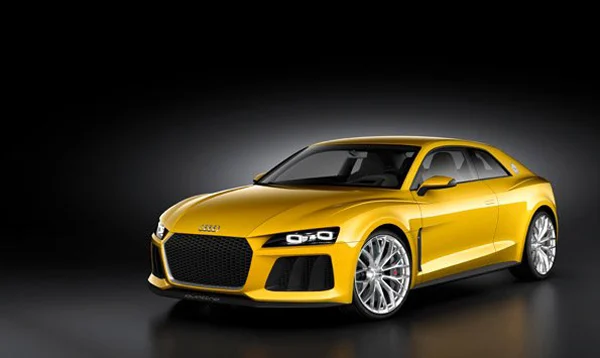Audi will be unveiling at the Frankfurt Auto Show this week what it says could be the legitimate successor to its popular Sport quattro, which itself was first unveiled in Frankfurt in 1983. The new Sport quattro concept, in keeping with the times of more and more vehicles adding green technology, will have under the hood a plug-in hybrid drivetrain.
The Sport quattro concept, according to Audi, will combine a a four-liter, twin-turbo V8 producing 412 kW (560 hp) and 700 Nm (516.29 lb-ft) of torque with a disc-shaped electric motor producing 110 kW and 400 Nm (295.02 lb-ft) that draws its traction energy from a liquid-cooled lithium-ion battery in the rear with a capacity of 14.1 kWh. Total system output will be 515 kW (700 hp), and the vehicle on display will consume on average 2.5 liters of fuel per 100 kilometers (94.09 US mpg), a CO2 equivalent of 59 grams per kilometer (94.95 g/mile).

image via Audi
Being as this is a plug-in hybrid design, it can drive up to 50 km (31.07 miles) on electric power only. An intelligent management ssytem controls the interplay between electric only and full operations, and the driver can choose between various operating modes. One of these modes, for example, is dubbed hybrid and in it
environmental and route data are used to compute the optimal use of the electric motor and combustion engine for fuel efficiency and implement this via the operating strategy. If navigation is active, the route is optimized for efficiency. This mode also includes the ability to customize the operating strategy. If the driver wants to retain a certain amount of electric range or to drive certain route segments on electric power, they can use the Hold or Charge function to precisely adjust the charge of the battery even without charging from the power grid.
When the V8 and the electric motor work together, the Audi Sport quattro concept accelerates from 0 to 100 km/h (62.14 mph) in 3.7 seconds and can hit a top speed of 305 km/h (189.52 mph).
There are many eye catching features to note on this concept car. A handful of them include angular, flat C-pillars; rectangular double headlights featuring Audi’s Matrix LED technology; a hexagonal single-frame grille with a new, sculpted grille insert; sporty racing bucket seats with folding backs, sculpted side bolsters and integrated head restraints up front and full rear seats; fully digital instrument cluster; and an air conditioning control unit, which is integrated directly into the air vents.






